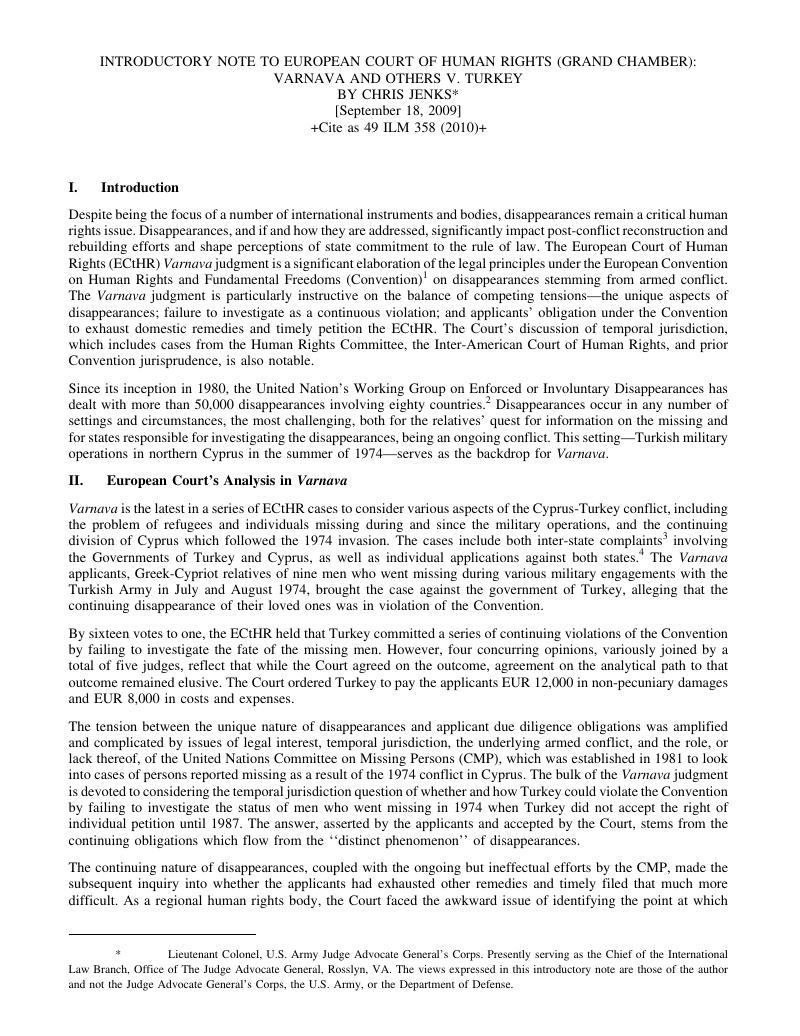Article contents
European Court of Human Rights (Grand Chamber): Varnava and Others v. Turkey
Published online by Cambridge University Press: 27 February 2017
Abstract

- Type
- International Legal Materials
- Information
- Copyright
- Copyright © American Society of International Law 2010
Footnotes
Lieutenant Colonel, U.S. Army Judge Advocate General’s Corps. Presently serving as the Chief of the International Law Branch, Office of The Judge Advocate General, Rosslyn, VA. The views expressed in this introductory note are those of the author and not the Judge Advocate General’s Corps, the U.S. Army, or the Department of Defense.
References
Endnotes
* This text was reproduced and reformatted from the text available at the European Court of Human Rights website (visited March 29, 2010) http://cmiskp.echr.coe.int/tkp197/view.asp?item=1&portal=hbkm&action=html&highlight=varnava&sessionid=53802193&skin=hudoc-en.
1 European Convention on Human Rights and Fundamental Freedoms, Nov. 4, 1950, 213 U.N.T.S. 222 (entered into force Sept. 3, 1953), as amended by Protocol 11, May 11, 1994, 33 I.L.M. 960 (1993), at http://www.echr.coe.int/nr/rdonlyres/d5cc24a7-dc13-4318-b457-5c9014916d7a/0/englishanglais.pdf.
2 Press Release, United Nations News Centre, UN Human Rights Group Looking Into 200 Cases of Enforced Disappearances (Mar. 15, 2010), http://www.un.org/apps/news/story.asp?NewsID=34084&Cr=disappearance&Cr1. While the number of disappearances is itself troubling, when the severe underreporting prevalent in disappearance cases is considered, the actual number is unfortunately likely to be much higher. The Chair of the Working Group stated that enforced disappearances “turns humans into non-humans” and lamented the continuing misperception that disappearances are a problem of the past.
3 See, e.g., Cyprus v. Turkey, No. 25781/94 (Eur. Ct. H.R. May 10, 2001), http://cmiskp.echr.coe.int/tkp197/view.asp?item=1&portal=hbkm&action=html&highlight=25781/94&sessionid=51646756&skin=hudoc-en.
4 See, e.g., Karabardak and Others v. Cyprus, No. 76575/01 (Eur. Ct. H.R. Oct. 22, 2002), http://cmiskp.echr.coe.int/tkp197/view.asp?item=1&portal=hbkm&action=html&highlight=76575/01&sessionid=51645853&skin=hudoc-en; and Baybora and Others v. Cyprus, No. 77116/01 (Eur. Ct. H.R. Oct. 22, 2002), http://cmiskp.echr.coe.int/tkp197/view.asp?item=1&portal=hbkm&action=html&highlight=77116/01&sessionid=51646688&skin=hudoc-en.
5 Under Article 35 of the Convention, the ECtHR may only deal with those matters submitted within six months from the final decision which exhausted all domestic remedies, also known as the “six month rule.”
1 See paragraph 11.
2 See paragraph 10.
3 See paragraph 9.
4 The document provided by the applicants listed 20 names, including that of Savvas Kalli which was the name under which this applicant had been recorded (see paragraph 80).
5 The first group of remains identified consisted of 13 Turkish Cypriots at Aleminyo; subsequent identifications were made of 22 Greek Cypriots at Kazaphani, Livadhia and Sandallaris, and
6 Turkish Cypriots in the Famagusta district. Their names have since been removed from the list of missing persons. 6 This Convention was opened for signature in February 2007. It will enter into force “on the thirtieth day after the date of deposit with the Secretary-General of the United Nations of the twentieth instrument of ratification or accession.” Only 5 States have ratified the Convention (Albania, Argentina, France, Honduras and Mexico).
7 The last two obligations are not only derived from the Inter-American Convention, but also from the Inter-American Convention on Forced Disappearance of Persons (2004) and the Inter-American Convention to Prevent and Punish Torture (1985), which may be invoked before the Court pursuant to Article 29 (d) of the Inter-American Convention.
8 See Sarma v. Sri Lanka, 16 July 2003, § 9.5. See also Edriss El Hassy v. the Libyan Arab Jamahiriya, 24 October 2007, § 6.8.
9 General Comment No. 6 (1982) at § 4.
10 See Bleier v. Uruguay, 29 March 1982, § 14.
11 See Edriss El Hassy v. the Libyan Arab Jamahiriya, §7.
12 See Mr. Farag Mohammed ElAlwani v. Libya, 11 July 2006. The HRC found a violation of Article 2 § 3 in conjunction with Articles 6, 7 and 9 with regard to the disappeared person and of Article 2 § 3 in conjunction with Article 7 with regard to the relative.
13 At § 6.2.
14 At § 11.
15 At § 12.2.
16 See the First Geneva Convention for the Amelioration of the Condition of the Wounded and Sick in Armed Forces in the Field (first adopted in 1864, last revision in 1949); Second Geneva Convention for the Amelioration of the Condition of the Wounded, Sick and Shipwrecked Members of Armed Forces at Sea (first adopted in 1949); Third Geneva Convention relative to the Treatment of Prisoners of War (first adopted in 1929, last revised in 1949); and Fourth Geneva Convention relative to the Protection of Civilian Persons in Time of War (first adopted in 1949), together with three additional amendment protocols, Protocol I (1977), Protocol II (1977) and Protocol III (2005).
- 1
- Cited by




